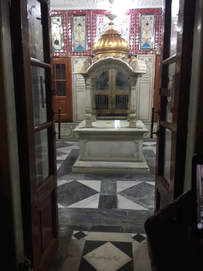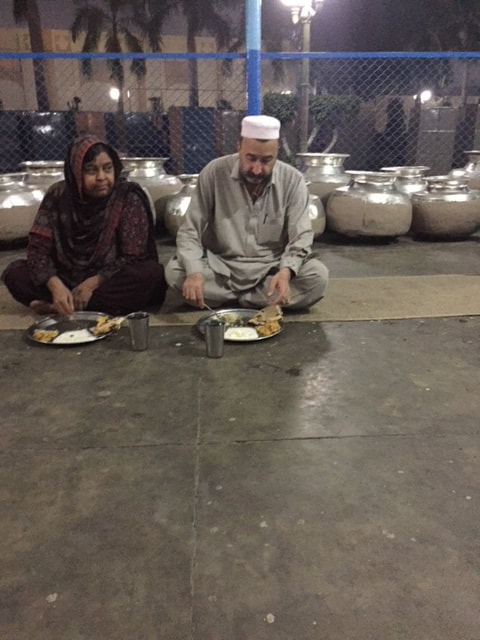
It was 4 am on November 17th, and the Turkish Airlines flight (where I was joined with my sister and brother-in-law, among others) was slowly gliding down on its approach to Lahore Airport. The lights of Lahore had started to come out from oblivion. Fear and excitement were running through my veins. I was enchanted by memories of the stories my mother told me about her childhood in Jhelum and those my father told me about his undergraduate days in Lahore at Khalsa College, but that was clouded with the horror of 1947. Leading up and through the partition, the violence and fleeing caused unforgettable pain to people who built their lives together for the past 5000 years. While leaving west Punjab (now Pakistan), the people of my parents’ generation and older would have never imagined they would forever leave the only place they knew of as home.
I thought of my mother walking miles with torn chappals (sandals) holding the hand of her three-year son (my eldest brother) and carrying another six months old son (my other brother) in her arms. Her caravan of 100 people walked over 50 miles to reach the safety of Amritsar in India.
In 1947, on both sides of Punjab, there was no oxygen, but only blood in the air. It seemed as though a hapless God had escaped to deep dungeons of Earth amid war cries of Allah ho Akbar, Bole So Nihal, and Har Har Mahadev. Fundamentalists were looking at heaven for redemption from their violent acts while creating hell on earth. It seemed as if Satan, the sorcerer, had made the sun emit black light under which disarray and malice conquered all.
The haunting memories created by the stories of partition were coming to me like a ceaseless vertigo of pain. I was born after partition, but I realized that the stories of partition had become a legacy of suffering and an important part of our family history.
I was lost in my own world when the plane landed. The immigration was a hassle-free process. After clearance, we were greeted by friends of the pilgrimage organizers. They took us to a hotel in an area called Liberty Market.
The morning was filled with a lucid stillness in the air, and the tangerine sun had started smiling from the east. Voices sharing the Punjabi hospitality greeting Jee Ayaan Noon (heartiest welcome) and sounds of Punjabi accents similar to my parents (Punjabi spoken in Pakistan sounds different than the one spoken in Indian Punjab) were everywhere. Even though my parent’s generation suffered during partition, they didn’t let their good memories of the land and the people be stained by the memory of bloodshed. I was beginning to breathe a sweet mist of my parents’ nostalgia of good times and as a result slowly my cocooned self was beginning to grow wings.
At around noon, we went to Liberty market. The sounds, smells, and hawkers looked very familiar. The overwhelming feelings generated by the familiarity of things made me question the senseless bloodshed of 1947. The welcoming tenderness in the corner of everybody’s eyes was beautiful. It is said that if one finds peace in the air, water, and land of a new place, then it is because the person’s hereditary consciousness dwells in that area. I didn’t have to convince myself about the validity of this belief.
By the afternoon, most of our group of 38 had arrived to Lahore. We assembled in the hotel lobby and then got onto organized buses for a visit to Gurudwara Dehra Sahib – the place of our fifth Guru’s, Guru Arjan Dev Ji’s, martyrdom. His martyrdom took place in May of 1606 (according to the Gregorian calendar).
According to 17th century sources, including contemporary poet and theologian Bhai Gurdas Bhalla (a Jesuit priest who was in Lahore at that time) and the Mughal Emperor Jahangir’s own biography, the Guru Ji was martyred due to fear of his rising popularity among masses. Jahangir felt threatened by other religions gaining power. He asked Guru Ji to convert to Islam and change a few verses of Adi Granth Sahib – a religious compilation of Gurus’ teachings. The order was refused. Guru Ji was tortured, and it is believed that he disappeared in the Raavi River after torture. There are fictionalized stories that came about in the eighteenth and nineteenth centuries involving other characters and ideas behind his martyrdom, but these stories hold no historical truth.
The place where Guru Arjan Dev Ji is believed to have disappeared is now dry land where the devotees have built his Samadhi (a structure commemorating the union of soul with God). A weak person like me cannot comprehend the moral strength of Guru Ji and his unwavering faith; at the age of 43, he gave up his life, refusing conversion to Islam. Looking at the Samadhi, I imagine the scene when Raavi was full of water and Guru Ji entered it with hundreds of onlooking devotees. Heavens cry through human eyes. Flowing tears of devotees must have made Raavi’s waters salty for a good amount of time. I remember a couple of lines from a poet requesting the waters of Raavi not to push around, because my lord has countless wounds (burns from the torture):
Raavi deya pania thokraan na maar, mahi dey shareer ute chale beshumar
Guru Arjan infused the core of Sikhism – morality and ethics - with warriorship. He was the first martyr in the religion. The path shown by him led to a line of thousands of Sikh Martyrs.
I was marveling at his accomplishments. At a young age of 17, he became our 5th Guru. In the short span of 26 years, he completed the construction of Harmandir Sahib (the Golden Temple), wrote the highest number of hymns of any Guru, compiled the Adi Granth Sahib, organized Sikh sangats (congregations) and langar (free, community kitchen) at broader scale, etc.
In the evening, my mind was entrenched in a web of thoughts as I reflected on his execution, the sacrifice of martyrs, and the rich history of Lahore (including contribution of Sikhs). In the Gurdwara, I saw a Muslim, Pathan couple from Peshawar eating langar (as shown in the picture below). There were many Muslims serving and eating langar. I could not escape the lingering thought that had Jahangir not ordered the execution of Guru Ji, our relationship with Islam would have been at a much different plane of understanding. I also believe that our historians did a very poor job of presenting facts, which complicates things and creates mind myths.
Lahore’s history is a labyrinth of blood shed, invasions, court intrigue, Sufism, etc. It would be easy for me to get lost in deep, tangled thoughts, but my Guru Ji lifts me out of this and reminds me I may never get the answer I’m seeking. Live this moment and relish the time here. The past is nothing but how you imagine it. Rotate the kaleidoscope and the picture will change. His beautiful composition of Sukhmani Sahib came to my mind, and I reflected on the following excerpt:
Sukhmani Sukh Amrit Prabh Naam, Bhagat Jana Key Man Bisram (Rahao)
(The name of God is Peace ( Jewel) of mind, (By Contemplation)
The mind of devotees abides in restful state, Pause and Contemplate

 RSS Feed
RSS Feed